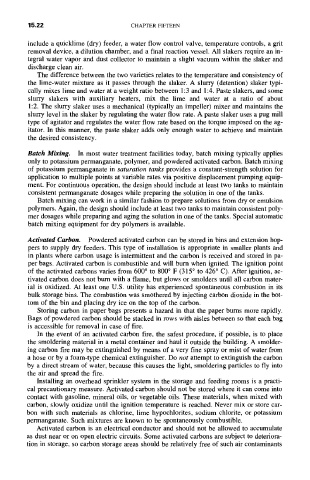Page 515 -
P. 515
15.22 CHAPTER FIFTEEN
include a quicklime (dry) feeder, a water flow control valve, temperature controls, a grit
removal device, a dilution chamber, and a final reaction vessel. All slakers require an in-
tegral water vapor and dust collector to maintain a slight vacuum within the slaker and
discharge clean air.
The difference between the two varieties relates to the temperature and consistency of
the lime-water mixture as it passes through the slaker. A slurry (detention) slaker typi-
cally mixes lime and water at a weight ratio between 1:3 and 1:4. Paste slakers, and some
slurry slakers with auxiliary heaters, mix the lime and water at a ratio of about
1:2. The slurry slaker uses a mechanical (typically an impeller) mixer and maintains the
slurry level in the slaker by regulating the water flow rate. A paste slaker uses a pug mill
type of agitator and regulates the water flow rate based on the torque imposed on the ag-
itator. In this manner, the paste slaker adds only enough water to achieve and maintain
the desired consistency.
Batch Mixing. In most water treatment facilities today, batch mixing typically applies
only to potassium permanganate, polymer, and powdered activated carbon. Batch mixing
of potassium permanganate in saturation tanks provides a constant-strength solution for
application to multiple points at variable rates via positive displacement pumping equip-
ment. For continuous operation, the design should include at least two tanks to maintain
consistent permanganate dosages while preparing the solution in one of the tanks.
Batch mixing can work in a similar fashion to prepare solutions from dry or emulsion
polymers. Again, the design should include at least two tanks to maintain consistent poly-
mer dosages while preparing and aging the solution in one of the tanks. Special automatic
batch mixing equipment for dry polymers is available.
Activated Carbon. Powdered activated carbon can be stored in bins and extension hop-
pers to supply dry feeders. This type of installation is appropriate in smaller plants and
in plants where carbon usage is intermittent and the carbon is received and stored in pa-
per bags. Activated carbon is combustible and will burn when ignited. The ignition point
of the activated carbons varies from 600 ° to 800 ° F (315 ° to 426 ° C). After ignition, ac-
tivated carbon does not burn with a flame, but glows or smolders until all carbon mater-
ial is oxidized. At least one U.S. utility has experienced spontaneous combustion in its
bulk storage bins. The combustion was smothered by injecting carbon dioxide in the bot-
tom of the bin and placing dry ice on the top of the carbon.
Storing carbon in paper bags presents a hazard in that the paper burns more rapidly.
Bags of powdered carbon should be stacked in rows with aisles between so that each bag
is accessible for removal in case of fire.
In the event of an activated carbon fire, the safest procedure, if possible, is to place
the smoldering material in a metal container and haul it outside the building. A smolder-
ing carbon fire may be extinguished by means of a very fine spray or mist of water from
a hose or by a foam-type chemical extinguisher. Do not attempt to extinguish the carbon
by a direct stream of water, because this causes the light, smoldering particles to fly into
the air and spread the fire.
Installing an overhead sprinkler system in the storage and feeding rooms is a practi-
cal precautionary measure. Activated carbon should not be stored where it can come into
contact with gasoline, mineral oils, or vegetable oils. These materials, when mixed with
carbon, slowly oxidize until the ignition temperature is reached. Never mix or store car-
bon with such materials as chlorine, lime hypochlorites, sodium chlorite, or potassium
permanganate. Such mixtures are known to be spontaneously combustible.
Activated carbon is an electrical conductor and should not be allowed to accumulate
as dust near or on open electric circuits. Some activated carbons are subject to deteriora-
tion in storage, so carbon storage areas should be relatively free of such air contaminants

